This post may contain affiliate links. Please read our disclosure policy.
How to dry thyme with one of three methods: in the oven, in a dehydrator, or naturally. As well as how to store, convert, and use the dried thyme!
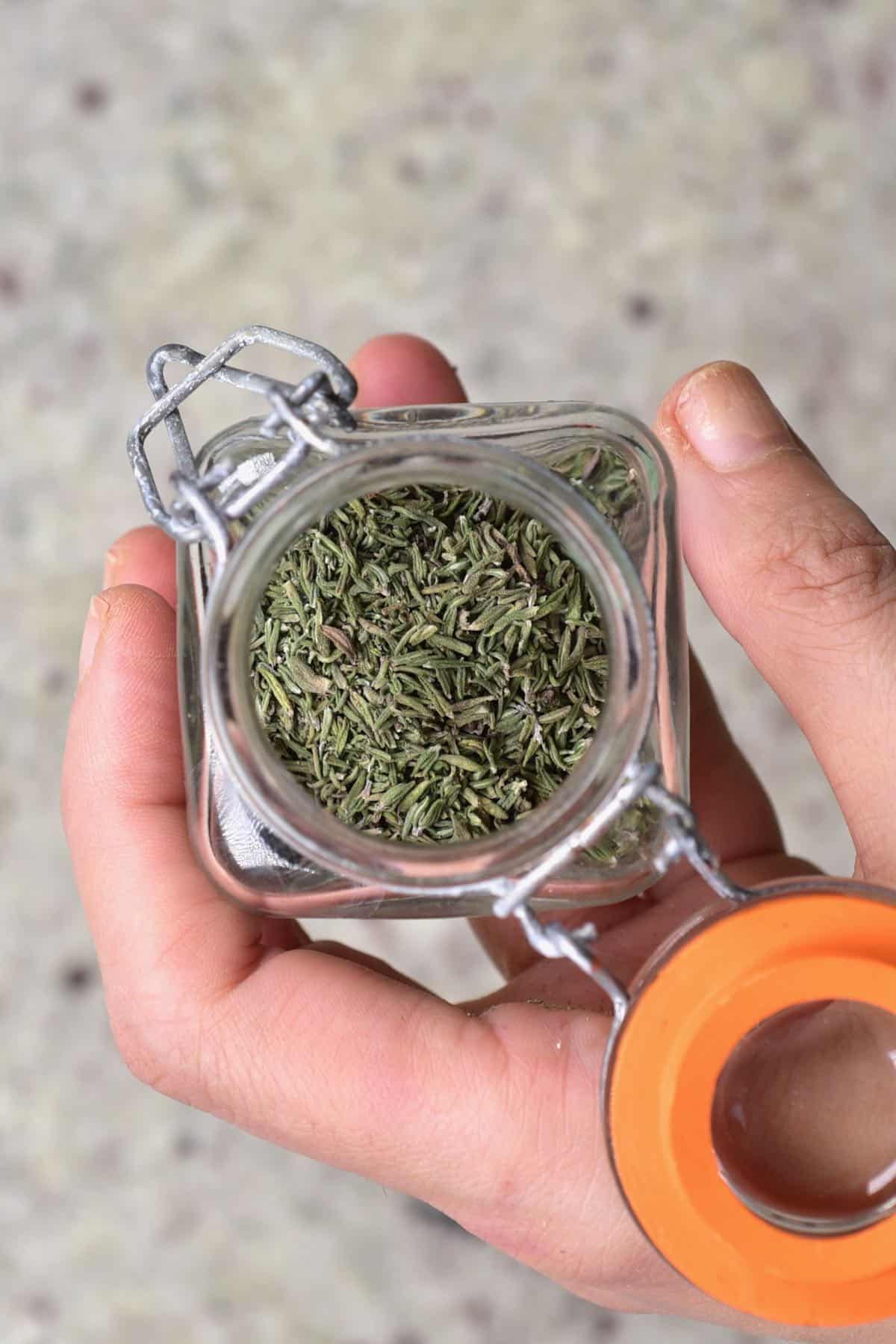
It probably doesn’t come as a surprise that my pantry is filled with various dried and preserved goods. From these ‘sun-dried’ tomatoes, coconut flakes, and powdered milk to this dried thyme. Learning how to dry thyme at home is incredibly easy and can be done using 3 different methods. In fact, I’ve already shared similar DIYs for dried mint, dried rosemary, and dried sage leaves.
I love to use fresh herbs whenever possible, and now that I have my own herb garden, I do so more and more. If I accidentally harvest/pick too much thyme from my plant, then I already successfully store herbs in the fridge and freezer. Yet I love to have a stash of dried thyme on hand for whenever the need does arise.
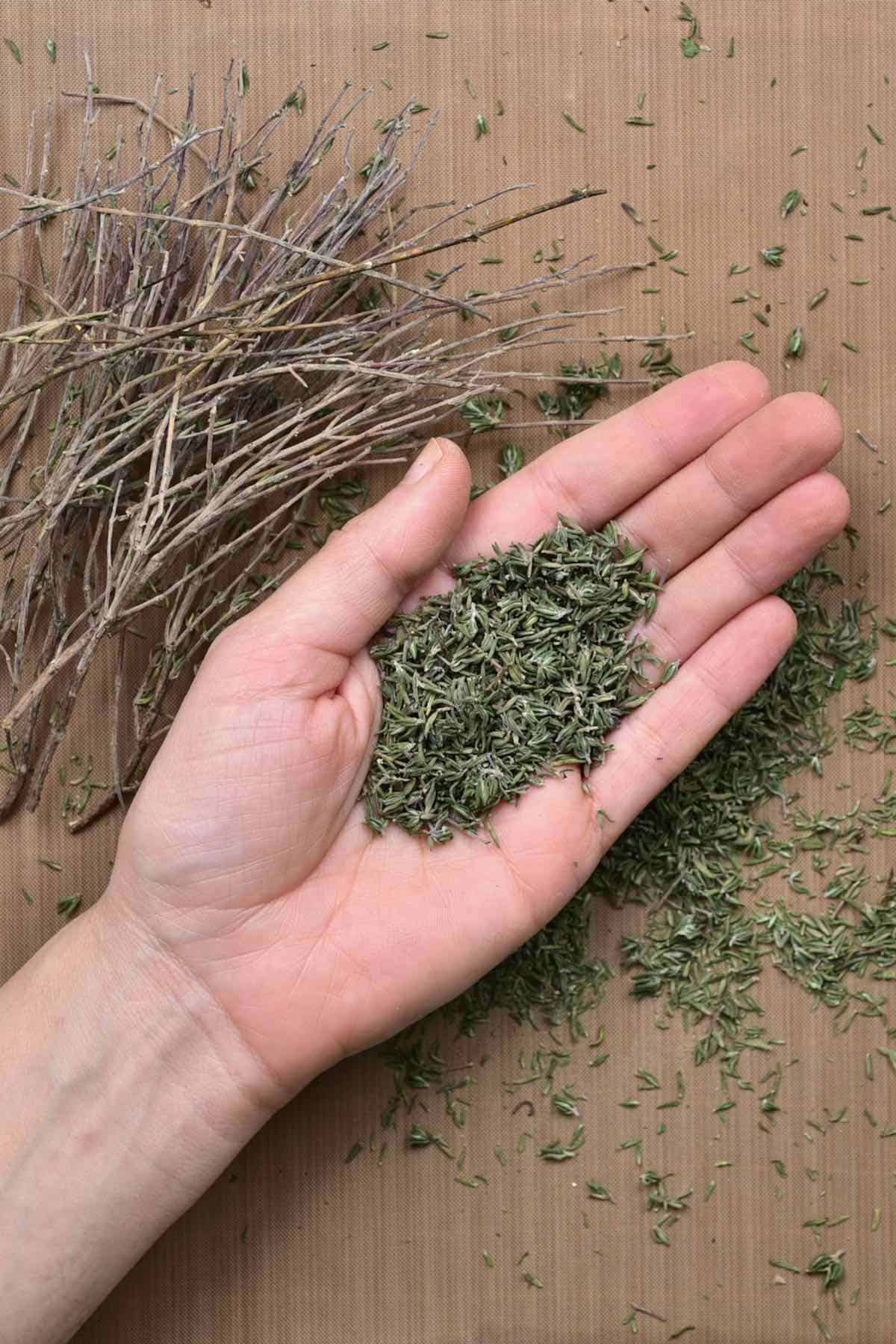
Within this post, I’ll take you through how to dry thyme in the oven, with a dehydrator, and air-drying. I’ll then also go through how to store and use thyme, and several FAQs (including the fresh thyme vs dried conversions!).
Want to save this recipe?
The Benefits of Thyme
Thyme is actually a herb from the mint family and is one of my most-used herbs (especially lemon thyme!).
More than for its flavor (which I find wonderful), it has a reputation for its bountiful health benefits.

For example, thyme is a rich source of vitamin A and C – both great for boosting immunity (as well as eye health). It is also a good source of iron, fiber, and copper.
There are studies to suggest that thyme extract could help lower blood pressure and cholesterol levels.
Plus, thyme essential oil is found to have antifungal and anti-pest properties too.
How To Dry Thyme
I prefer to dry my herbs in a dehydrator when possible, for drying that uses less heat than an oven (so no risk of burning), and at a much faster pace than air-drying. Dehydrating thyme is super simple and can be done in just a few steps.
Top Tip: Air-drying thyme is best for those living in warm, dry climates – at around 68ºF/20ºC.
Step 1: Wash and pat dry the thyme
Add the thyme to a large bowl of water and swish the herbs around gently to clean them. Then drain the water and, optionally, use a salad spinner to get rid of as much excess water first before patting dry. Otherwise, go straight to patting them dry.
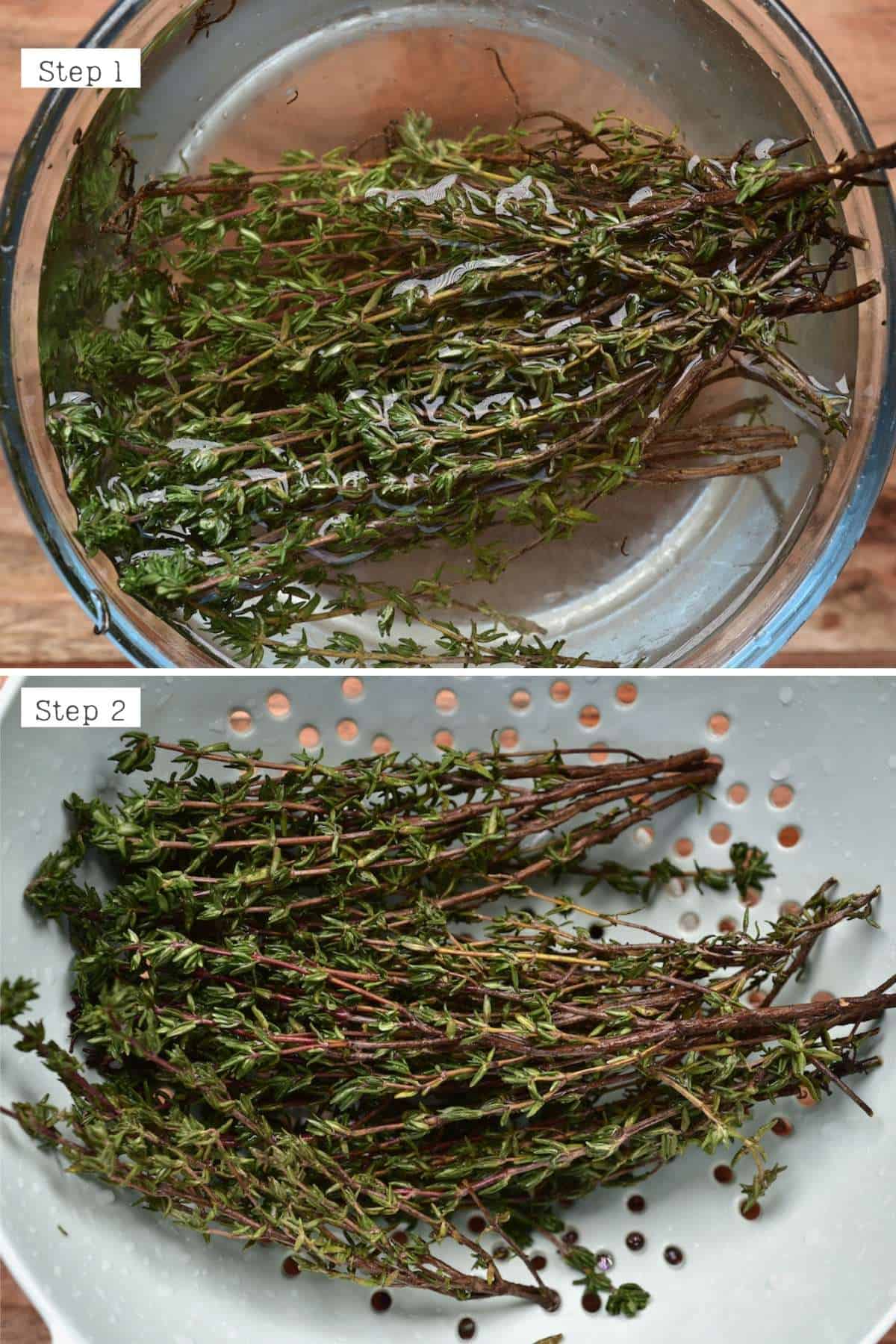
It’s important to get rid of ALL the excess moisture before drying the thyme so it can be a good idea to let it air-dry for an extra 30-60 minutes, pat dry once more, and then move on to the next step.
Step 2: Dry The Herb
In A Dehydrator
You can do this on or off the stems, but the drying time will vary.
Lay the thyme in a single layer over the dehydrator tray/s, leaving some space in-between, for the air to circulate.
Dry the thyme at 105°F/40°C for between 2-5 hours, until it is completely dry and brittle.
The time will vary based on your machine, how much you’re drying, the climate you live in, etc.
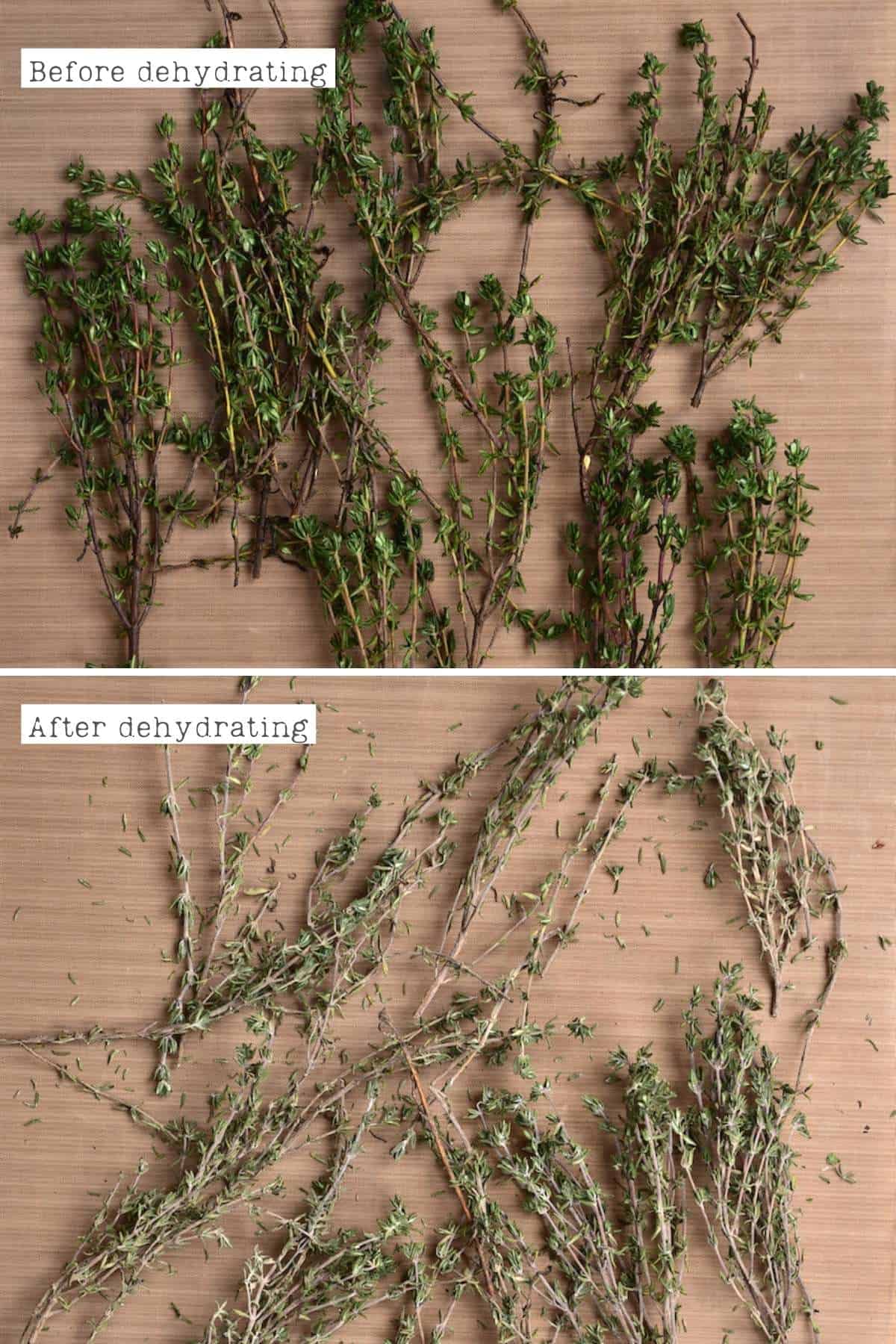
In The Oven
Lay the thyme on a parchment-lined baking tray/s, with space between for the air to circulate.
Place the tray in the oven at its lowest temperature. Depending on the temperature, this process will take a different amount of time.
For example, 120ºF/50ºC may take between 2-4 hours. 180ºF/80ºC may take 1-2.5 hours.
If your oven doesn’t go lower than 212ºF/100ºC, you may want to prop open the oven door. This will lower the temperature AND allow for better airflow. You could prop open the door with a heat-proof wooden spoon or potholder.
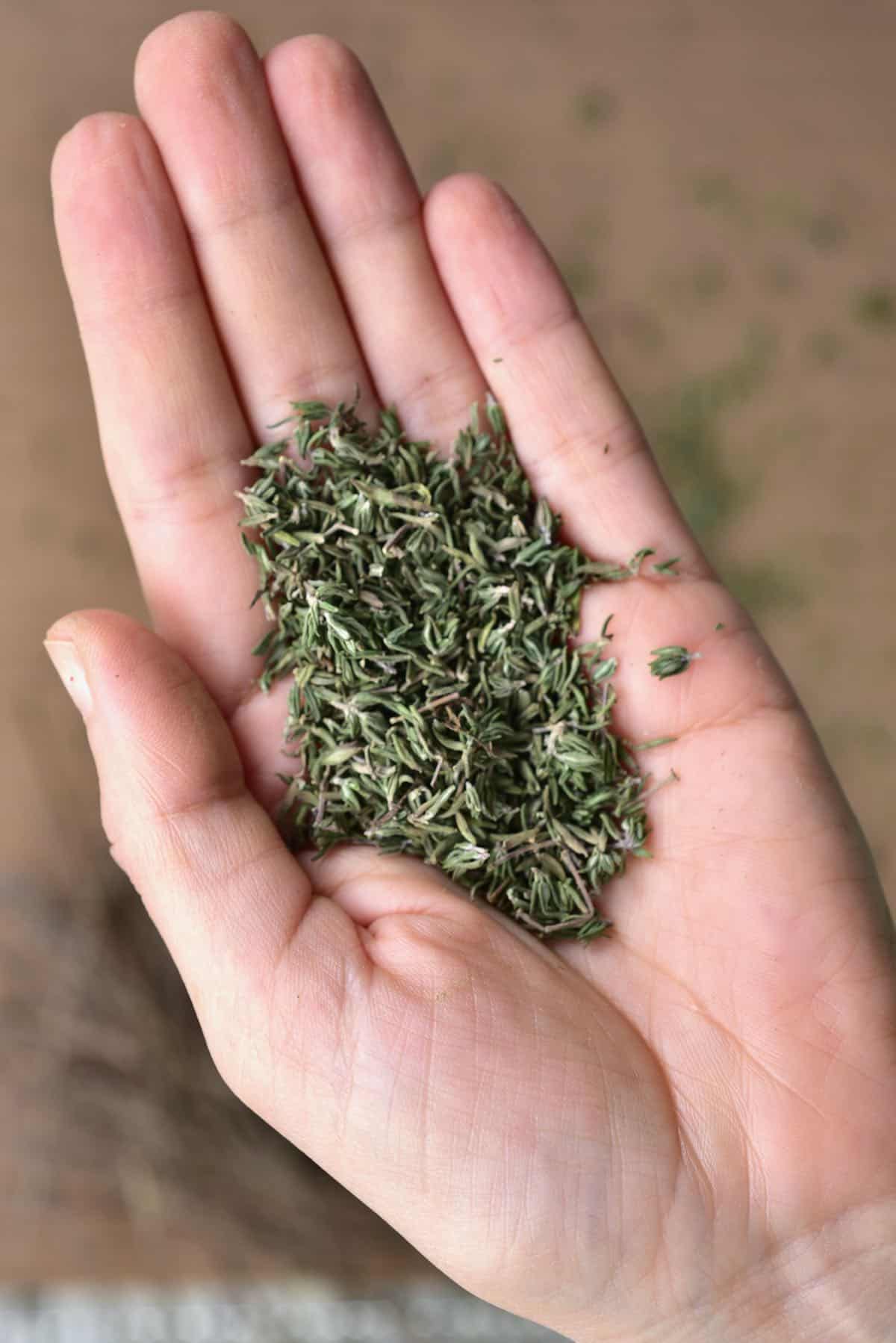
Air-drying
Create a small thyme bouquet, tying the sprigs together at the stem with a piece of twine/string.
Hang the herbs (from more string) on a clothes hanger, or use a herb drying rack in a well-ventilated, warm area away from direct sunlight.
The thyme will take between 1-2 weeks to dry, depending on the weather and climate.
It’s a good idea to cover the thyme with a ventilated ‘protective covering’ like a paper bag or nut milk bag – to avoid dust or critters settling on the herbs.
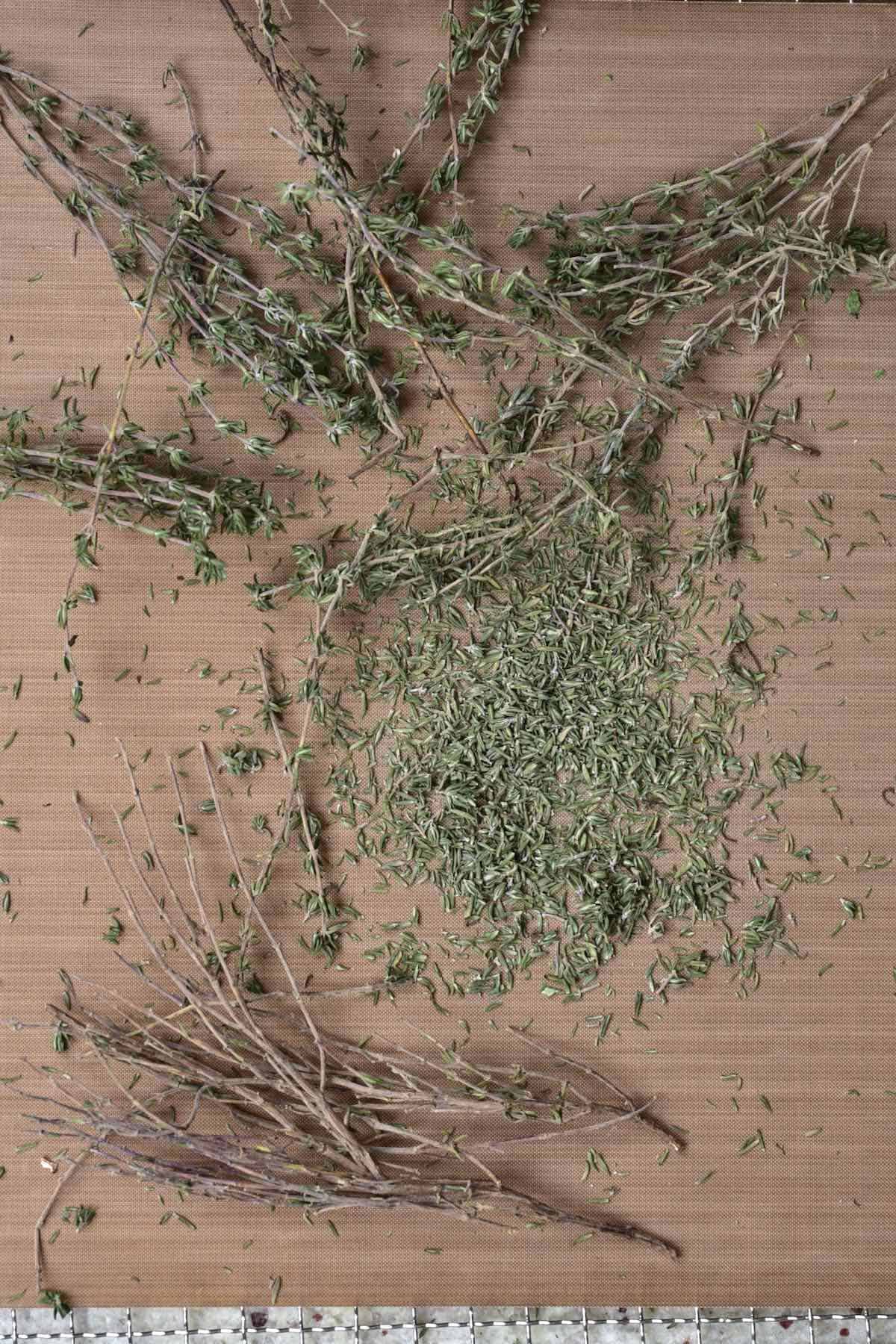
How To Store Thyme
Once dried, allow the thyme to cool entirely, remove the leaves from the stem, and transfer them to a clean, airtight glass jar.
You can store the thyme whole, crumble it (by hand), or grind it into a crumble/powder (with a coffee/spice grinder or food processor).
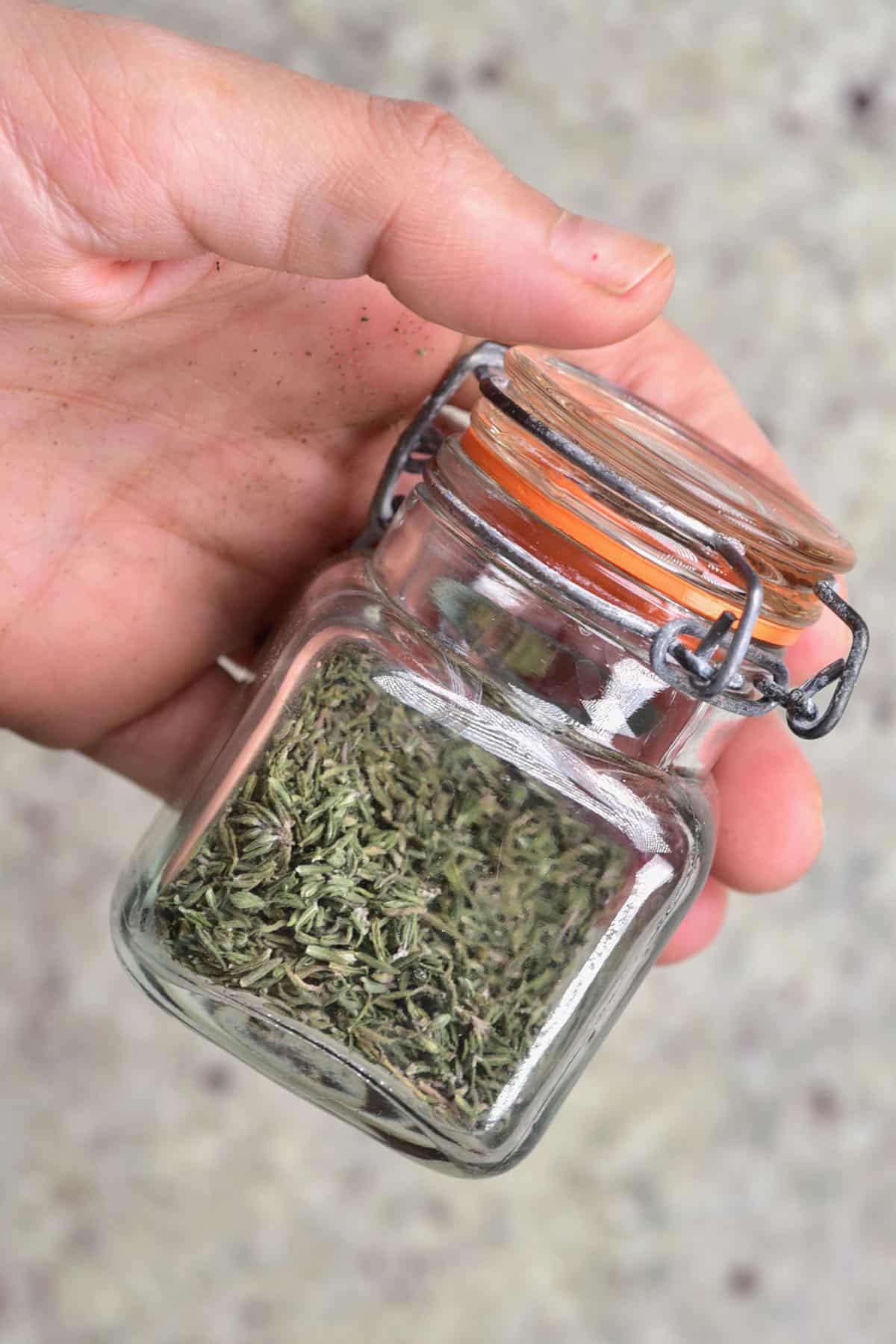
Store the jar in a cool, dark location for up to a year for optimal freshness, though it will be fine for 2 years (or longer, though the quality declines).
How to freeze thyme? There’s no need to freeze the dried thyme but it can help to extend the shelf-life of the herb even further. Store it in a freezer-safe, airtight container in the freezer for up 2 years.
How To Use Thyme
There are tons of ways to enjoy this dried thyme. This herb pairs well with several different ingredients including beans, meats, eggs, cheese, etc. Here are just a few of my favorite ways to use dry thyme leaves;
- In spice blends or for herb salt – like Lebanese Zaatar Blend (za’atar), Italian Seasoning, etc.
- For Herbed Thyme Butter.
- Added to berry dishes – like this Mixed Berry Compote or jams.
- Mixed into cheese – like cream cheese, Goat Cheese, Herby Vegan Feta, etc. It would also work well with this baked camembert wreath.
- In bread – like this homemade naan, NY-style Bagels, or this pull-apart bread.
- In crackers– Like these seeded crackers or Naturally Coloured Healthy Crackers.
- With roasted vegetables – like Roasted Potatoes or Potato Skin Chips.
- Within pasta dishes – like this Roasted Tomato Sauce, Creamy Vegan Mushroom Sauce or Easy And Delicious Marinara Sauce.
- Over pizza – like these Easy Zucchini Pizza Bites, Low-Carb Cauliflower Mini Pizzas, etc.
- Within marinades and dressings – like this Healthy Blackberry Dressing.
- With slow-roasted dishes like garlic confit/ tomato confit.
Thyme also works well within baked goods too – cakes and scones, etc.
FAQs
If you grow your own thyme, it’s best to harvest it just before it blooms, for the best flavor. Harvest them in the morning, cutting the stem from the plant (above the woody part). rather than just picking away the leaves.
Herbs like basil, oregano, marjoram, or even Italian Seasoning (which contains thyme) will all work as a dried thyme substitute.
Use 1/3 the amount of dried thyme to fresh thyme.
I.e., 1 teaspoon of dried for 3 teaspoons (1 tablespoon) fresh thyme.
Related DIYs
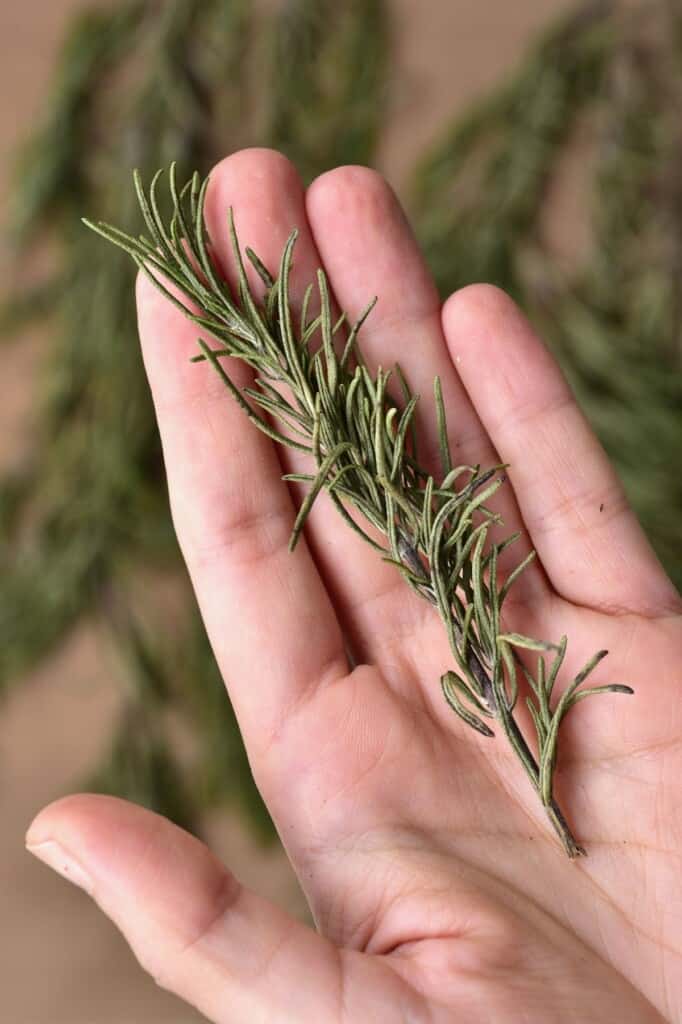
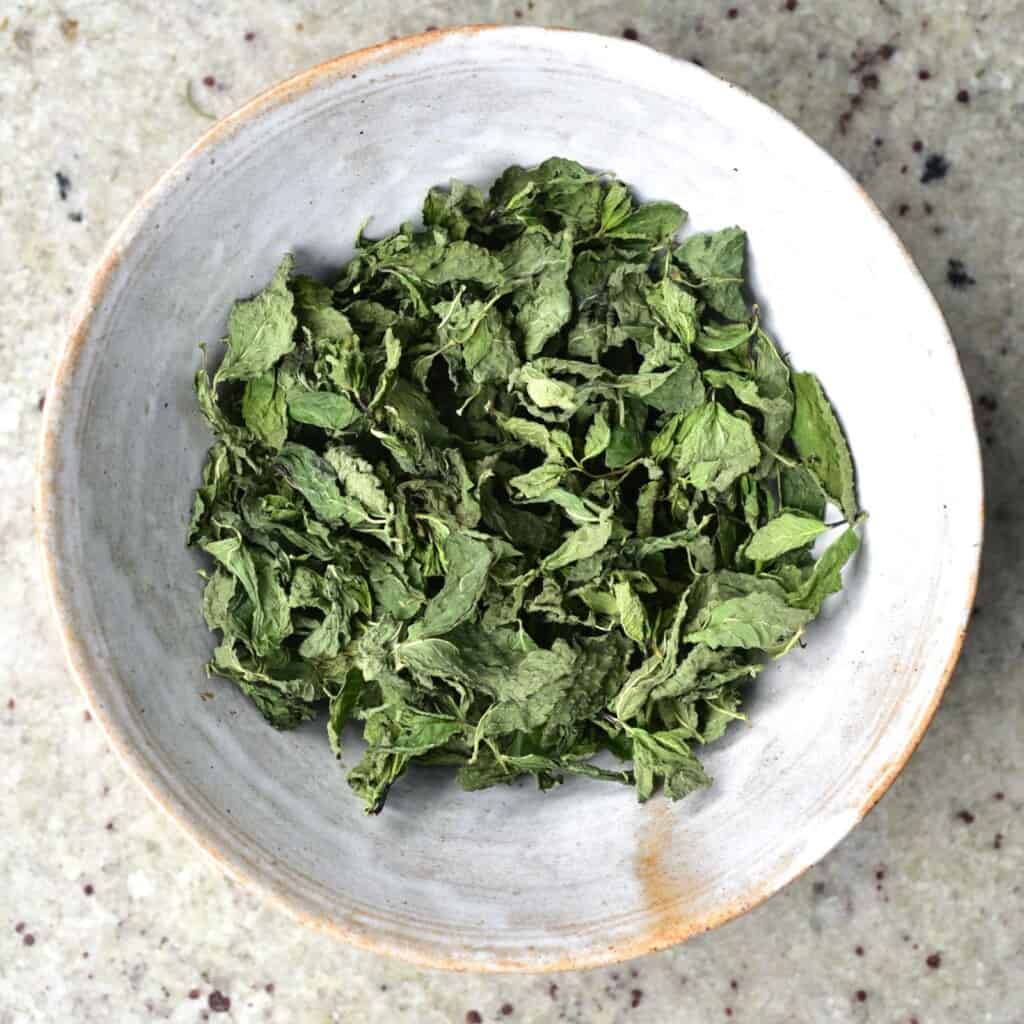
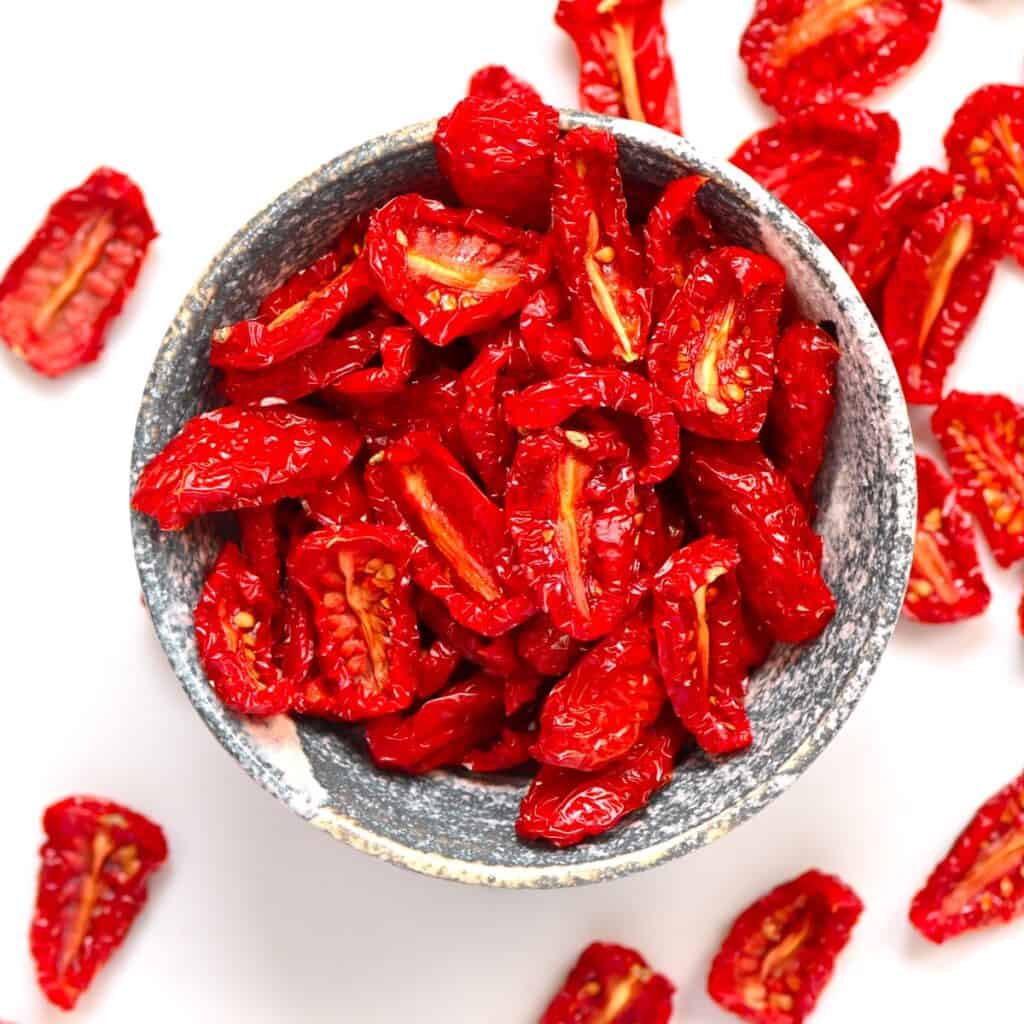
- How To Dry Rosemary
- How To Dry Mint
- “Sun-Dried” Tomatoes (In Oven or Dehydrator)
- DIY Dried Mushrooms
- Homemade Ginger Powder (Two Methods)
- Garlic Flakes (+ Dried Minced Garlic)
- Onion Flakes (2 methods)
If you try this dried thyme DIY, then let me know your thoughts and any questions in the comments. I’d also really appreciate a DIY rating and would love to see your recreations – just tag @AlphaFoodie.
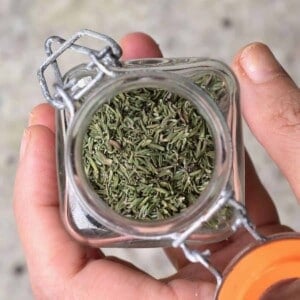
How To Dry Thyme (3 Methods)
Equipment
Ingredients
- 4 oz thyme
This much fresh thyme will yield about 1 oz/25 g dried thyme
Instructions
Step 1: Wash and pat dry the thyme
- Add the thyme to a large bowl of water and swish the herbs around gently to clean them. Then drain the water and, optionally, use a salad spinner to get rid of as much excess water first before patting dry. Otherwise, go straight to patting them dry.It's important to get rid of ALL the excess moisture before drying the thyme to it can be a good idea to let it air-dry for an extra 30-60 minutes, pat dry once more, and then move on to the next step.
Step 2: Dry The Herb (choose one method)
In A Dehydrator
- You can do this on or off the stems, but the drying time will vary.Lay the thyme in a single layer over the dehydrator tray/s, leaving some space in-between, for the air to circulate.Dry the thyme at 105°F/40°C for between 2-5 hours, until it is completely dry and brittle.The time will vary based on your machine, how much you're drying, the climate you live in, etc.
In The Oven
- Lay the thyme on a parchment-lined baking tray/s, with space between for the air to circulate.Place the tray in the oven at its' lowest temperature. Depending on the temperature, this process will take a different amount of time.For example, 120ºF/50ºC may take between 2-4 hours. 180ºF/80ºC may take 1-2.5 hours.If your oven doesn't go lower than 212ºF/100ºC, you may want to prop open the oven door. This will lower the temperature AND allow for better airflow. You could prop open the door with a heat-proof wooden spoon or potholder.
Air-drying
- Create a small thyme bouquet, tying them together at the stem with a piece of twine/string.Hang the herbs (from more string, a clothes hanger, or even using a herb drying rack in a well-ventilated, warm area away from direct sunlight.The thyme will take between 1-2 weeks to dry, depending on the weather and climate.It's a good idea to cover the thyme with a ventilated 'protective covering' like a paper bag – to avoid dust or critters settling on the herbs.
How To Store Thyme
- Once dried, allow the thyme to cool entirely, remove the leaves from the stem, and transfer them to a clean, airtight glass jar.You can store the thyme whole, crumble it (by hand), or grind it into a crumble/powder (with a coffee/spice grinder or food processor).Store the jar in a cool, dark location for up to a year for optimal freshness, though it will be fine for 2 years (or longer- though the quality declines).
- How to freeze thyme? There's no need to freeze the dried thyme but it can help to extend the shelf-life of the herb even further. Store it in a freezer-safe, airtight container in the freezer for up 2 years.
Notes
Nutrition
Nutrition information is automatically calculated, so should only be used as an approximation.


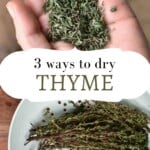
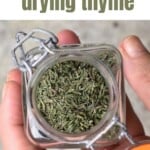
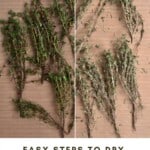









The nutrition facts are wild. Who knew thyme was so unhealthy! Just kidding, I’m sure it’s an error. The article was very helpful as I have an abundance of thyme this year
Thanks for pointing out this, Donna. Indeed, it was calculating the nutrition for the whole amount while one would usually use just a pinch or a teaspoon of dried thyme. It’s now updated with the estimated nutrition per teaspoon.